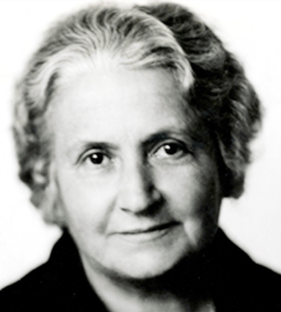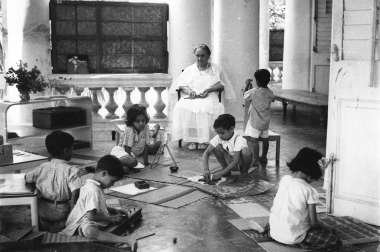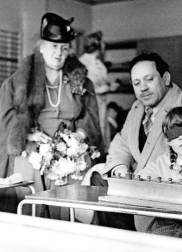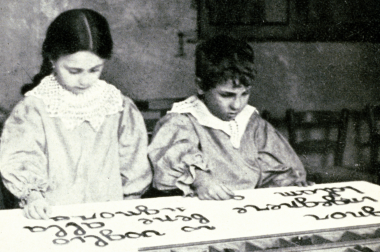Montessori method


Through observation, the Italian doctor Maria Montessori discovered that in every child exists the full potential of the person who they will become one day. If children have an environment around them that supports and satisfies their curiosity, this potential can develop fully. Maria believed that children want to get to know the world around them and to learn new things. They are naturally curious and enjoy discovering the world.
Montessori built her first Casa dei Bambini, or Children's House, in 1907 and continued her work across continents. She earned the love of children, the admiration of parents and the respect of professionals. She loved her work and the children and dedicated her life to changing the world's view on education.
Although Maria Montessori was born more than 150 years ago, her ideas are still alive and relevant today. Only in a respectful and inspiring environment can children grow up and become creative and kind adults with a desire to develop further.
The story of Maria Montessori
Maria Montessori was born at a time of many changes - social, political, and economic but it was still a time when women were not free to study, vote and work. She gave birth to an illegitimate son and was forced to give him away to satisfy the social conventions of her time. She had to watch while totalitarian rulers were destroying her work and, due to her views, she had to flee from her homeland, Italy, for many years.
Despite many challenges, she never gave up and her efforts led her to develop a method which changed the focus of children’s education and continues to inspire educational reform. She was nominated for the Nobel Peace Prize three times. Mahatma Gandhi shared her view on the child's mind: “If we were humble and modest, we could learn the greatest lessons of life not from adult scholars, but from so-called unknowing children."
Today there are thousands of Montessori schools and preschools around the world, and the Montessori method is promoted by many as a model for the teaching of the future.
-
1870
Maria Montessori was born in Chiaravalle, central Italy, more than 150 years ago to the family of a senior official at the Ministry of Finance. Maria's mother came from a family that appreciated education and she was a passionate reader, which was unusual for Italian women at that time.
-
1896
Despite her father's initial opposition, Maria decided to pursue a career as a physician, and in spite of the many challenges of learning in a male dominated environment filled with social prejudices, she was the first woman in Italy to receive the title Doctor of Medicine. Soon after that, she was chosen to represent Italy at two women's conferences, in Berlin in 1896 and London in 1900, where she defended the rights of working women.

-
1900
As part of her medical practice, Maria had the opportunity to work with a group of children from a psychiatric clinic, and her observations led her to recognize that children form themselves from what they find in their surroundings. Thanks to their efforts, the children from her group passed state exams with better results than those of ordinary schools, and for the first time, her findings attracted the attention of the public.
-
1901
Maria became deeply interested in the process of children’s learning and returned to university in 1901, this time to study psychology and philosophy. In 1904 she became a professor of anthropology at the University of Rome.
-
1907
Her desire to help children was so strong that in 1906 she gave up both her place at the university and her medical practice to work with a group of sixty young children from working-class families in a very poor part of Rome. It was there that she founded the first Casa dei Bambini, or "Children's House," as she called her schools.

-
1909
In Italy, Maria found many teachers who were passionate about her method so in 1909 she began the first educational training in Rome for about 100 students. At that time, she also wrote her first book, which was soon translated into more than 20 languages. She organized further training for teacher education and founded model children's houses. Across Europe, the Montessori method began to attract supporters and quickly spread around the world. Model schools were created in the UK, France, Switzerland, Argentina and the US. On her travels, she was accompanied by her adult son, Mario, who for the rest of her life became her strong support and a promoter of the Montessori method.

-
1917
At the invitation of the Spanish Government, Maria moved to Barcelona. In Spain, she set up a training center and soon also opened educational Montessori courses in London and the Netherlands.
-
1924
Maria first met Benito Mussolini, who initially supported her method. Maria received the support of the Italian Government and funding to expand her method to all Italian schools. The cooperation that seemed advantageous at first, soon became bitter because the fascist regime did not want free choice and other basic principles of the Montessori method.
-
1933
The Nazis in Germany began mass closing of Montessori schools, and due to the incompatibility of the Montessori pedagogy principles with the fascist ideas, Maria had to leave Spain, where she was living at that time. Maria and Mario traveled to London and then to Amsterdam, which became their home for some time. In Laren, near Amsterdam, she opened another training center with a model school.
-
1940
In 1939 Maria and her son accepted an invitation to spread the Montessori method in India and spent several months there. The following year, Italy joined Germany in World War II, and the British colonial government began to treat Maria and Mario - Italian citizens - as enemies. Maria was put under house arrest and her son was taken to a detention camp - he was released only on the occasion of Maria’s 70th birthday as a gesture of respect for her.
-
1946
Maria and Mario finally managed to leave India only after the end of the war. They then returned to Europe to resume their work. In 1949, Maria was first nominated for the Nobel Peace Prize, followed by two more nominations in 1950 and 1951.
-
1952
Maria died in the Netherlands and is buried in Noordwijk aan Zee near Amsterdam.

Principles of Montessori pedagogy
Respect for the child
Respect for themselves, for others and for the environment are the basic principles of Montessori pedagogy. Every day brings many opportunities to build community in the class, where we encourage respect for others and the ability to express our own thoughts and emotions.
Help me to do it myself
These words, which a small child spoke to Maria Montessori, have become the main credo of her pedagogy. The task of adults is to help children acquire new knowledge and skills about the world surrounding them at their own pace.
Children know what they need
Although children develop in contact with the environment from which they draw stimuli, only they themselves are best able to recognize how and when they need to integrate them into their actions.
Learning with all senses
Children want to touch everything, feel everything, and want to use objects. They want to explore, gain new information and imitate the activities of adults. This helps them understand the world and develops their thinking and speech.
The right moment
During their development, children go through stages where they are sensitive to various stimuli. Our job is to recognize these stages and help the child make the best use of this time to acquire particular skills.
Free choice of work
The child has the opportunity to influence what he or she will do, who he or she will work with and for how long. However, freedom of choice also has its limits, because freedom and discipline are mutually conditional. They are "two sides of the same coin." During activities, children learn about their capabilities, but also their limits - the current limits of their skills and reason, the boundaries of things, time and the boundaries set by parents and teachers. The freedom to choose activities within clear and comprehensible rules gives the children the necessary time and space to satisfy their curiosity and creative self-expression.
Three-year cycles
In Montessori three-year cycles, children of three consecutive years join in one class, giving them the opportunity to experience different roles. The smallest observe more and try to imitate their older friends who are their role models. The older ones who are more experienced and happy to advise, help with what is too difficult for their other classmates to do; they work on more complex tasks themselves, while showing their work to younger children.